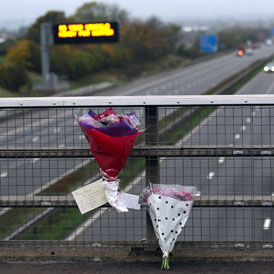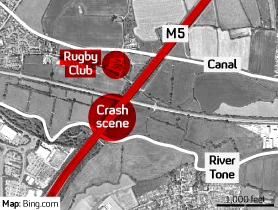Using technology to make driving safer
As investigations continue into the cause of the crash on the M5 which killed seven people, Channel 4 News looks at how our motorways could be made safer.

The M5 pile-up follows years where there have been relatively few casualties on Britain’s motorways.
Motorways are often described as the safest roads in the UK, but they are not without their risks.
With 70mph speed limits and multiple lanes, they leave little margin for error.
Efforts to limit the number of deaths on the roads has so far focused on reducing speed, but the AA’s Edmund King has told Channel 4 News tailgating is a bigger motorway risk than speeding.
Both traffic engineers and car manufacturers have stepped up efforts to make driving safer through better road and vehicle design.
Car braking has been improved in recent years with the introduction of non-locking brakes.
There is also a mechanism to control the speed of lorries with built-in controls that limit their speed to 63mph.
But more sophisticated measures are becoming widespread in motoring.
Paul Watters, the AA’s head of roads policy, said technology like adaptive cruise control, which automatically brakes your car when the one in front brakes, are among some of the measures introduced to prevent tailgating.
But he warns that older vehicles and lorries with different stopping speeds could reduce the effectiveness of these mechanisms in practice.
Flow breakdown can occur when a car suddenly brakes and the cars following respond creating a ripple effect.
The delay is multiplied throughout the queue meaning that it will take longer for the motorist at the back to be on the move again compared with the person who first braked.
Car modifications
Adaptive cruise control: ACC uses a radar sensor to check for moving objects ahead in the same traffic lane. It maintain a set constant vehicle speed but if a preceding slower vehicle is detected, ACC will reduce the engine power and – if necessary – apply brakes to maintain a set safe following distance.
Lane departure warning: monitors a vehicle’s position in the lane and alerts drivers when they leave the lane without signalling. Some systems steer the vehicle back in between the lines.
Automatic emergency braking: Detects a potential crash ahead and alerts the driver. If no action is taken, the system warns the driver again, prepares for a crash and applies the brakes to mitigate or avoid the collision.

Road management measures to reduce flow breakdown include the active traffic management system on the M42 east of Birmingham.
More common is the older MIDAS signalling system which operates on more than 1,000km of road across the UK.
MIDAS signalling is in operation on the M5 in Somerset at a number of sites including between junctions 26 and 25 on the northbound carraigeway – approximately half a mile ahead of where the incident took place.
A spokesperson for the Highways Agency told Channel 4 News that the signals were triggered by queuing traffic folliwing the collision but would not have been triggered by the collision itself.
On the stretch of the M5 where the accident happened there have only been two previous fatalities over the past five years – this happened over a mile away on the opposite carraigeway.
Mr Watters said that to be effective, traffic management measures must be targeted at accident blackspots. He added that drivers can lose their trust in traffic management measures when they are triggered erroneously, or cancelled too late.
Mr Watters added that these measures were no substitution for safe driving and the normal rules of good observation and forward planning still apply.
“The person in control is the person with their hands on the wheel and their foot on the accelerator,” he said.
Engineering measures
Active traffic management: sensors in the road detect the amount of traffic there is. If they detect congestion, the built-in system automatically calculates the best speed to keep the traffic flowing, which will be enforced using digital enforcement technology.
MS4 ‘pictogram’ signs: these are new-style matrix road signs that display picture and text messages. It is thought that they will be more easily and quickly understood by drivers, allowing more time to react, reducing the likelihood of further accidents.
Motorway incident detection and automatic signalling (MIDAS): this automatic queue protection is currently in operation on 1,015 kilometres of motorway in England. It uses induction loops to detect slow moving, queuing or stationary traffic and sets upstream signs automatically to show to drivers 40mph and 60mph advisory speed limits.
-
Latest news
-
As India goes to the polls in the world’s largest election – what do British-Indians think?6m

-
Tees Valley: Meet the candidates in one of the biggest contests coming up in May’s local elections4m

-
Keir Starmer says public sector reform will be a struggle7m

-
Nicola Sturgeon’s husband Peter Murrell charged with embezzlement of funds from SNP1m

-
Ukraine might finally get $60billion in American weapons and assistance to defend against Russia3m

-




